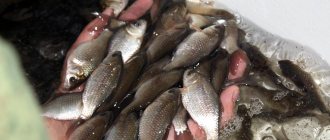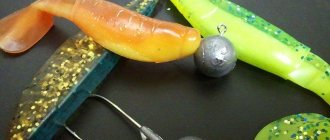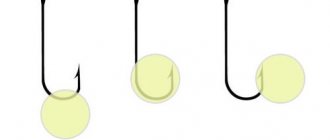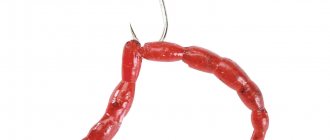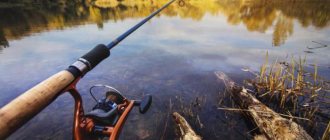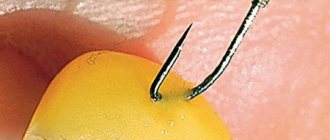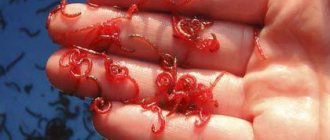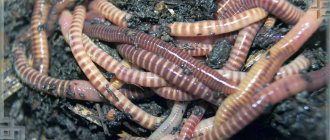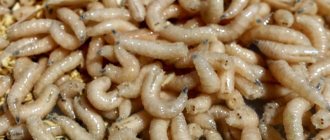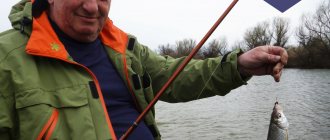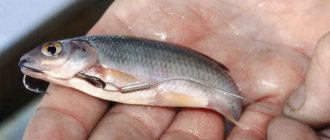Every fisherman should be able to properly place bloodworms on a hook. This mosquito larva bait is considered a universal bait, not only for the vast majority of peaceful fish, but also for any season of the year. Planting bloodworms without skill is not so easy. Apart from its small size, the larva is quite delicate and, if not carefully installed, flows off the hook and does not attract fish.
The article presented to the reader will reveal the secrets of several effective methods of attaching bait, and will also introduce the fisherman to a special device for mounting the larvae in a beam, revealing the technique of using this useful tool.
What should be the hooks for bloodworms?
To use mosquito larvae for fishing, hooks with the following parameters are used:
Red thin steel hook
- size – for mounting bloodworms, choose miniature hooks 12–16 numbers according to the European classification;
- fore-end size – for fishing, hooks with a long fore-end, which ends with a fastening ring, are selected;
- color – should effectively camouflage the hook with the bait attached to it, for which special models coated with bright red paint are used;
- thickness - to ensure that the bloodworms do not leak out and are minimally damaged, choose models made of thin and steel wires.
The basis for selecting a hook is the size, thickness, shape of the accessory and the sharpness of the tip. Dull hooks lead to damage to the nozzle, and at the slightest suspicion of a worn edge, it is sharpened with fine sandpaper.
We recommend Gamakatsu LS-1010 series hooks. With a long fore-end and made of thin wire. What you need to attach a bloodworm.
How to put a bloodworm on a hook
Depending on the fishing conditions, there are a number of ways to attach bait. The specificity of the conditions includes the type of fish caught, its activity and size. The fish's bite differs in intensity, which, in turn, varies from the aggressiveness of the fish's feeding. Sometimes the fish immediately swallows the bait, in other cases it tries it by sucking on the bloodworm or sharply hitting it and thus knocking it off the hook. For each type of bite, there is a method of planting larvae, which we will introduce the reader to in the continuation of the conversation.
Standard method
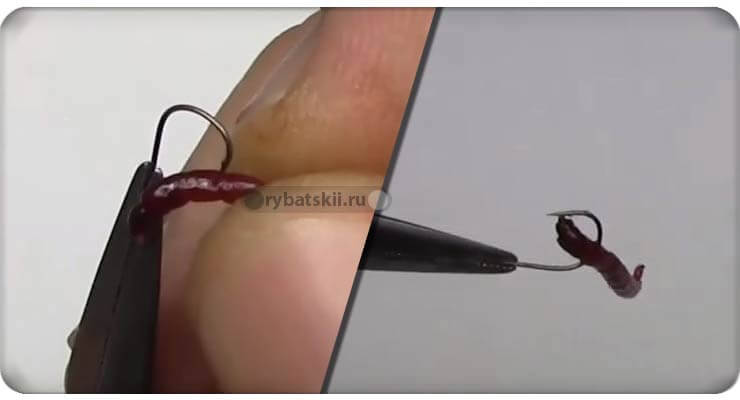
Standard method
With this technique of mounting a delicate bait, the bait is taken with the index finger and thumb. Next, the third segment of the larva from the head, which is clearly visible on the body of the worm, is carefully pierced with a point. The tip of the hook is pulled outward, and the larva itself is moved to the middle of the hook of the accessory. Thus, it is possible to bait not only a single specimen of even a small moth, but also a portion of bait from 2 to 5 larvae.
The method is suitable for actively taking fish and, in particular, fishing with a winter feeder. Basically, this technique is used to equip gear for catching small and medium-sized fish.
According to experienced anglers, baiting a bloodworm across is more effective, since there are fewer empty bites.
Head attachment

Head impaling
Taking a closer look at the red worm, it is easy to identify its head, which is dark, closer to black, with a clearly noticeable point at the end. Follow the following algorithm for mounting the larva by the head:
- The larva is gently pressed with two fingers of one hand, while its head will protrude above the holding index and thumb by 2–3 millimeters.
- The tip of the hook extends exactly in the middle of the ring of the larval body located below the head and extends outside the body of the worm.
Attaching the bloodworm to the head allows the larva to remain alive and active in its movements for a long time; it is harder for the fish to knock it off the hook, which increases the effectiveness of bites. Often perch and ruffe are caught this way, aggressively hitting rigs with bait .
Ring attachment method
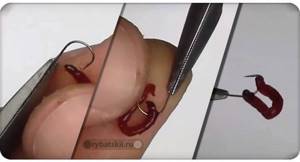
With a ring
Another popular and frequently used technique is the method of attaching a moth with a ring. The process will require some skill, which is quickly developed with a couple of trial attempts at the nozzle. The manipulation looks like this:
- The first segment is pushed onto the sting, under the head of the worm, bringing the tip out.
- The same operation is carried out with the tail of the worm, bending the body into a ring.
A correctly mounted bloodworm is on the hook rolled into a ring, which fully imitates the behavior of a worm in its natural conditions in the bottom layer of a reservoir, without arousing suspicion in the fish.
The technique is applicable for passive fish, when bites are barely noticeable, and their development turns into a sluggish and weakly flowing process with a blurred hooking moment. By baiting a bloodworm with a ring, they catch fish of the most varied types and sizes.
Stocking attachment
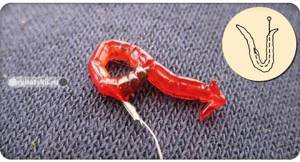
Stocking
Mounting a butterfly with a stocking refers to the formation of thin baits that allow you to catch cautious and capricious fish. This way you can catch roach, where even one copy of the larva brings positive results. The method algorithm is presented below:
- Using a hook, we prick the first ring from the head of the worm.
- Without pulling the tip of the hook out of the body of the moth, it is carefully pulled towards the tail of the bait.
- Without extending the hook a couple of segments to the tail of the worm, the tip is left in the body of the moth.
After installation is completed, the nozzle is carefully inspected for leaks. If the bloodworm is leaking, it needs to be replaced with a new worm, since otherwise, after just a minute of being in the water, the liquid will flow out and only a shell that is unattractive to fish will remain on the hook.
This method is suitable when there are a lot of empty bites.
Belt attachment
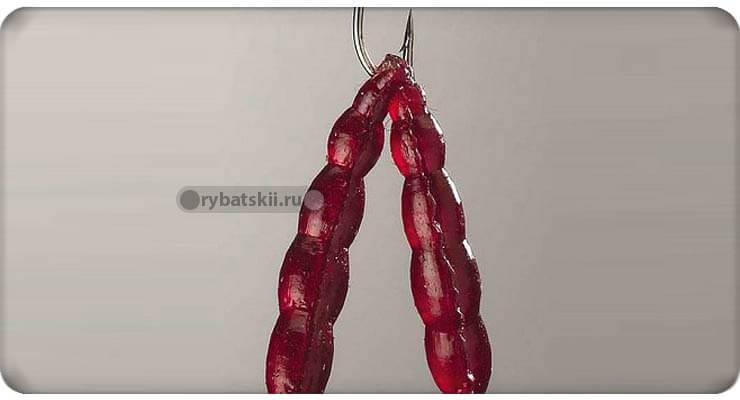
Belt attachment
The method of attaching the bloodworm to the hook using the belt method helps to delicately place the bloodworm on the hook. This method is intended for catching inactive and suspicious fish. Often crucian carp are caught in this way by mounting the bait. The belt mounting technique will require several preliminary training sessions. The nozzle process is carried out using the following manipulations:
- The worm is pricked with a sting exactly in the middle.
- Next, draw the hook towards the head inside the shell to the length of 2-3 segments and pull it out.
- After this, the bloodworm is moved to the middle of the hook shank, making sure that the head of the bloodworm is turned toward the top of the rig during this manipulation.
How to properly attach a bloodworm to a jig
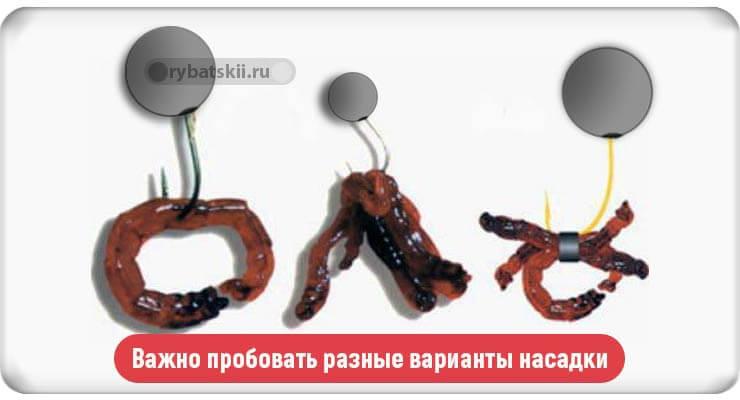
Different ways to attach bloodworms to a jig
Ice fishing in most cases is carried out using a jig. For fish that are cautious and not very active in winter, fishermen use small jigs. Even large bream can be caught on a tiny hook and sinker combination. Bloodworms are placed on jigs in any of the following ways, choosing it based on the intensity of the bite and the aggressiveness of the fish.
And also, depending on the shape and size of the jig, combine the attachment methods, for example, put two bloodworms using the attachment method behind the head or belt, and attach the latter with a ring or stocking. This technique will allow you to find an effective option for presenting bait. This will help you get a larger number of bites, and sometimes a more weighty trophy, cutting off annoying little things.
Rich catch
In order to get a rich catch and not return home empty-handed, you should take care not only of bait, but also of other gear. An important factor for successful fishing is proper bait. Here you need to focus on the type of fish you want to catch. After all, some of them prefer to feed at the very bottom, while others are closer to the surface.
If you are going to fish with bloodworms, then you should add very little of it to the bait. It should attract fish with its smell. Bait should be carried out in advance, and not before fishing.
Tips for fishing with bloodworms:
- Many experienced fishermen claim that fishing for bloodworms in their habitats is a waste of time. After all, here the fish are already quite accustomed to this food and may simply not react to the larvae. Therefore, in order to return home with a catch, you should choose places where bloodworms are not found. Then successful fishing will be guaranteed to you.
- Fishing for mosquito larvae will be more active during weather changes, as well as during the cold season.
- The ideal bait is very active and bright.
- The main thing for a successful event is knowledge of the area, bottom topography, habitat of certain fish species, well-chosen gear and bait. When it comes to fishing, there are no small details that can be left unattended.
- It is recommended to choose gear specifically for this type of fishing.
- The line should be as inconspicuous as possible in the water so as not to scare away the fish.
- You should also choose a small jig so that the fish’s attention is focused only on the bait.
- If the bite is very weak, then preference should be given to the “ring” bait method. In this case, it is necessary to monitor the sting: it must be completely hidden. Then the fish will be able to completely swallow the bait and not fall off the hook.
Bunch tie for attaching bloodworms
In addition to the above methods of installing larvae, the method of feeding bait in a bunch is also effective in catching fish. Resourceful and skillful fishermen have invented a special device for convenient manipulation of the installation of small baits - the bundle knitter. Purchasing and mastering the skills of using a tool greatly speeds up and simplifies the process of catching bloodworms.
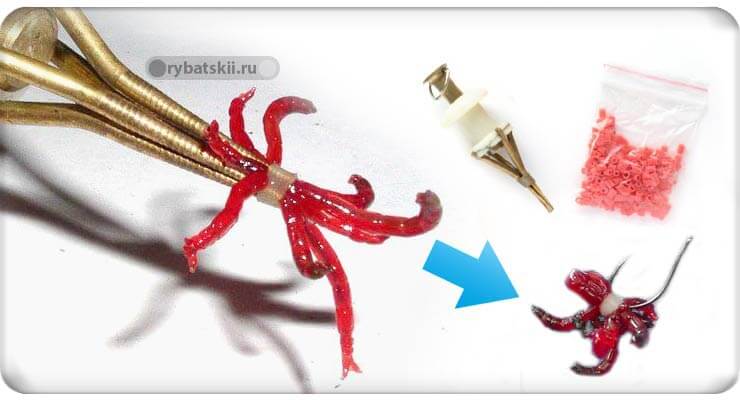
This is how bundle knitting works
The classic, simplest in design and convenient bundle knitting machine is assembled from a body with a movable and sliding lever-key, an L-shaped clamp, as well as a removable conical cap. To assemble and secure the bloodworms into a bundle, the product manufacturer offers a package of thin elastic band of bright red color in the kit for the device. A bunch of natural, energetically moving worms stimulates a stable fish bite both in winter from under the ice and in summer, in open water.
How to plant a bloodworm in a bunch
You can correctly attach bloodworms with a bunch of tufts after the first training. We recommend conducting the practical lesson according to the following algorithm:
- The elastic band is placed on the conical cap of the bundle and slides onto the lower part of its body.
- The cap is then removed from the instrument body.
- Using the key, the clamp is pulled out of the bundle body.
- Next, the clamp is lowered into a jar of bloodworms.
- As a result of the movement of the keys, five to six larvae are collected into a miniature and dense bunch.
- The excess larva is carefully removed from the formed bunch, sending it back to the cache with the nozzle.
- Feeding an elastic band from the body, the bundle collected from the larvae is compressed, after which the bait is mounted on the hook.
To save time on the pond, experienced fishermen prepare bunches in the comfort of their own homes and store them in boxes while fishing.
The use of bunchworm is more justified in winter when the bloodworms freeze and it is necessary to make the attachment as quickly as possible.
Advantages of the method
The beam installation method has a number of significant advantages:
- comfort and convenience, because thanks to the simple design of the bundle, even a novice angler can handle the assembly of the bundle;
- saving time, since in practice attaching a beam will take the fisherman 3–5 seconds;
- the naturalness and naturalness of the beam - fastened with a dense but thin elastic band, the moths with their mobility attract the attention of even passive fish;
- a bunch of bloodworms stays on the hook longer, and therefore bait is saved and the periods of its change are extended.
Threading "by the belt"
This technique is similar to sports. The larva also makes its way through the center, but the tip is brought out, leaving the head and tail of the bloodworm hanging down. Having figured out this method, you can significantly speed up the catching of perch, roach and bleak during intense biting. Bait placed in this way is very attractive to these fish .
To increase efficiency, you can plant two or three larvae at a time.
When catching large prey (bream, pike, etc.), experienced fishermen prefer to attach mosquito larvae in bunches, securing them with self-made cuffs. You can secure the bait with small pieces of elastic from the nipple.
You can perform this action in ten to twenty seconds . You just need to thread a bunch of bloodworms into the ring, and then grab it with a hook. You can make the procedure even faster with the help of a special device that you make yourself. You need to take the body of a regular ballpoint pen and cut off one end of it with a knife strictly at a bevel. The end result should be a small scoop.
A rubber ring is stretched over this structure and is located next to the sharp part. Using the scoop made, the larvae are collected, after which the cuff is pulled together, taking the bait with it.
Having spent half an hour or an hour making rings, the fisherman gets an excellent opportunity to come fishing in full gear, hoping for a big catch. In addition, the cuffs often remain in the same place after the bloodworm is eaten by the fish, so they can be used repeatedly.
